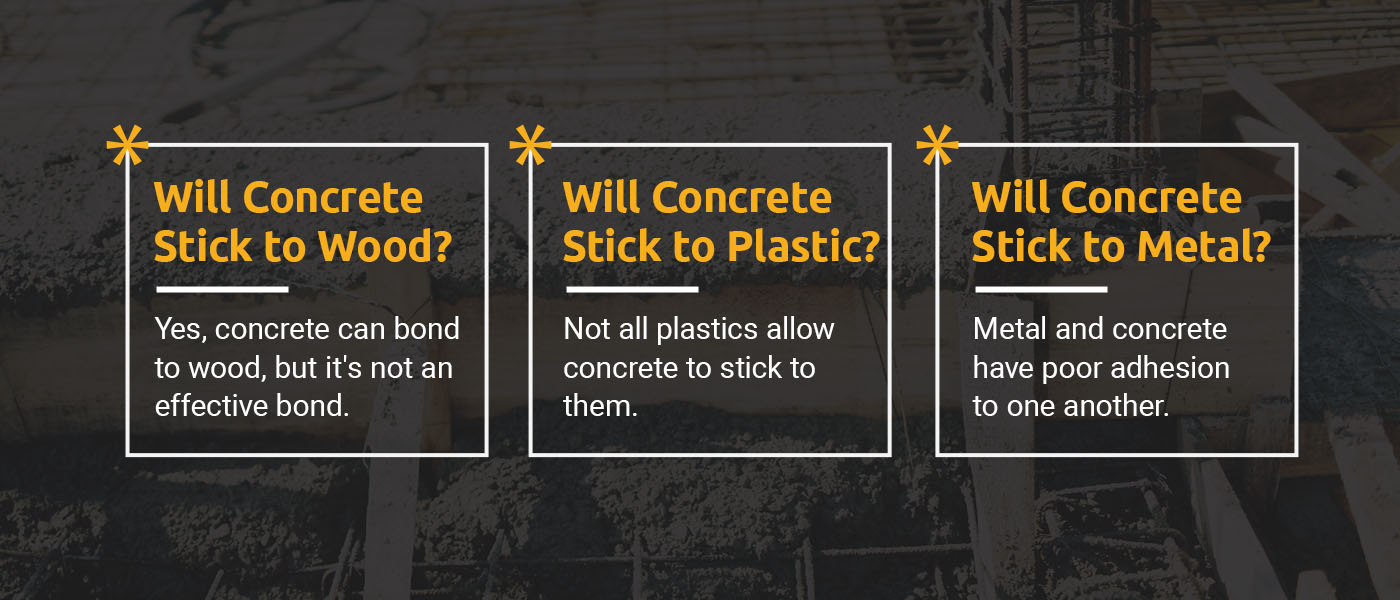
Guide to Concrete Adhesion
Posted By:Dynamic Concrete Pumping , Date: Jan 30, 2024

- How Concrete Adhesion Works
- Will Concrete Stick To Wood, Plastic, or Metal?
- Can Weather Impact Concrete Adhesion?
- What Will Concrete Not Stick To?
Concrete is known for its strength but not bonding. Understanding what concrete will stick to — and what it won’t — is essential when you’re pouring new concrete or repairing it. It will help your concrete application go right the first time without causing problems later on.
In this guide, we will explain the science behind concrete adhesion and the various materials it will and will not work with.
How Concrete Adhesion Works
Cement, which is part of the concrete mix, does not have any natural bonding agents. In many cases, freshly poured concrete will not bind to the other material but be separate. This issue means a lack of a sound structure for weight-bearing surfaces, such as floors and foundations.
You’ll need to use a bonding adhesive to encourage adhesion between the concrete and the other substance. After prepping the surface, use a brush, broom, roller or sprayer to apply the bonding agent. Depending on what kind you get, it will keep moisture out and resist wear and tear from traffic.
In some instances, concrete will naturally bond to other materials. To prevent concrete from sticking to these materials, you need to treat them with a release agent to keep the concrete from sticking by forming a thin lubricant film over the material. When the concrete is dry, it’s easy to separate.
A few different kinds of release agents exist, including:
- Oil-based: Barrier oil release agents such as linseed, mineral and paraffin create a physical film that prevents the concrete from sticking.
- Water-based: This variety is a non-toxic release agent made from organic materials, like vegetable oils and won’t change the color of the concrete.
- Reactive: These chemically active release agents work by a chemical reaction with the concrete to form a soapy film that prevents sticking.
Will Concrete Stick to Wood?
Yes, concrete can bond to wood, but it’s not an effective bond. Wood is the one material that concrete can stick to temporarily. Contractors typically lay wooden panels before pouring concrete to create a foundation. Once the concrete cures, they remove the wooden boards.
Lumber mills often pretreat their wood with oil-based blends to make it stick-resistant. If your wood has not already been treated, you may have to purchase a commercial agent and apply it yourself.
Will Concrete Stick to Plastic?
Not all plastics allow concrete to stick to them. Concrete can stick to high-density polyethylene (HDPE) plastic, but other forms of plastic, such as siliconized or rubberized plastic, do not allow adhesion. If you use a plastic bucket to mix concrete, you can take steps to prevent it from sticking. Using a formal release agent or oil-based lubricant to coat the bucket before mixing concrete can help prevent sticking.
Will Concrete Stick to Metal?
Metal and concrete have poor adhesion to one another. When concrete is poured over metal, the bond separates for a few reasons, including the different thermal expansions between the two materials or corrosion on the metal surface. Because the bond separates relatively quickly, you need to use a bonding agent or physical fasteners to attach the two materials.
Can Weather Impact Concrete Adhesion?
The weather conditions have a significant impact on the way that concrete cures. The setting time will vary while pouring concrete in hot or cold weather is possible, the setting time will vary. Colder weather can weaken concrete or cause problems with the curing process. An adhesive may also not work when the weather is cold.
When the weather fluctuates above and below freezing, it causes a freezing-thaw cycle in concrete. Concrete has water molecules that expand when they are frozen. When this happens, it strains the material. The freezing and thawing in the concrete cause the concrete to expand and weaken, potentially causing it to crack sooner.
If you need to pour concrete in the cold, use a mix with accelerators. You’ll also need to take extra precautions with the curing process by using insulation blankets, heated enclosures or temperature-controlled water to encourage proper curing.
Similarly, you can pour concrete in hot weather, but extreme heat may pose challenges. The water in the concrete may evaporate too quickly, resulting in shrinkage, cracks and weakness. Direct sunlight can also cause the surface to dry too fast.
What Will Concrete Not Stick To?
Concrete does not adhere to:
- Concrete: You’ll need a bonding agent to stick wet concrete to dried concrete.
- Molds: Most concrete molds are made from urethane rubbers that resist concrete bonding.
- Paint: There are no natural bonding agents in paint.
- Oil: Oil or oiled surfaces create a film that prevents concrete from sticking.
- Glue: You’ll need to remove the glue from a surface before pouring the concrete.
- Mortar: You must apply a bonding agent before pouring concrete over the mortar.
To promote adhesion, you’ll have to add the bonding agent yourself to get the concrete to work properly. If you’re repairing existing concrete, you’ll need to get the concrete to bind to these materials so that the repair lasts as long as possible.
Get a Consultation With Dynamic Concrete Pumping
While concrete is a strong material, it generally doesn’t bond well with other materials. Before pouring it, you need to understand how well it will stick. There are various binding agents available for different materials. Before choosing one, research to find the right agent for the job.
Do you have a concrete project in Alberta that you need to get right? At Dynamic Concrete Pumping, we have more than 40 years of experience working with concrete, and we’ll be happy to consult with you about your project specs. Fill out our contact form today.



